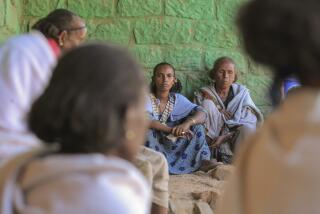Ethiopia Moving People to Villages : Relief Official Calls Program Well-Intentioned but ‘Scary’
- Share via
ADDIS ABABA, Ethiopia — Farming families, sometimes carrying their disassembled huts on their backs, are being moved from scattered homesteads into villages under a new government program that may spread across Ethiopia.
Called “villagization,” the program began without fanfare several months ago in the vast southwestern region of Harerge and is expected to begin soon in other regions. Western relief officials in Ethiopia say they became aware of it only in the last few weeks.
The program has some parallels with the government’s ambitious resettlement program, which is intended to move more than a million people from drought-affected northern regions to more fertile areas in the southwest.
Relief officials say both programs further the government’s efforts to collectivize the country, but they note that the villagization program will allow farmers to stay in their native districts.
An official of the Marxist government, requesting anonymity, said the goal is to move isolated farm families to new or existing villages where for the first time they can have easy access to such basic services as education, health care and water supplies.
An official of an American relief agency said he is convinced that the program is well-intentioned but nonetheless described it as “scary.”
Like most Westerners interviewed about the program, he asked not to be identified because he considers the topic politically sensitive.
“We’re very nervous about it, about the speed and the scale of it,” the relief official said. “People are going to be moved without any infrastructure in place.”
Fear of Erosion
He said families selected are required to move. He also expressed fear that construction of new housing, in cases where farmers do not move their own huts, will further deplete Ethiopia’s wood and brush, causing more soil erosion.
However, Desmond Taylor, head of the United Nations’ World Food Program operation in Ethiopia, said the program might strengthen conservation efforts. He said that, by grouping farmers together, the government can exercise greater control over farming practices that cause deforestation or soil erosion, two of the factors that have contributed to Ethiopia’s severe drought problems.
Taylor suggested that the reaction of Western relief agencies to the program will depend in large measure on how it is carried out. Many farmers, he said, might not want to leave their homesteads or land where relatives are buried.
The Ethiopian official said farmers moved under the program will continue to farm their own lands, but will have to walk farther to do so. The government, he said, felt it worth requiring farmers to spend more time traveling in order to reduce the time it takes women to fetch water and children to walk to school. “Now, many women spend six to 10 hours a day carrying water,” he said.
Much of Ethiopia, which is twice the size of France, is covered with mountains or high plateaus giving way to cliffs and gorges. Many peasants must spend a day walking down and then back up steep, narrow paths to bring water to their homes from some small stream beds thousands of feet below.
The official said he is aware that some Westerners are suggesting that the program is coercive, and he acknowledged that it will probably increase government control over people’s lives.
“Nobody wants to forgive us for turning communist,” he said. “If people can be provided with water, medical treatment, security, why do others have to look to see if there is a negative aspect?”
The program is not directly related to Ethiopia’s slowly waning famine, he said, but will enable more people to be helped faster in the event of a recurrence.
One Western diplomat said he and his colleagues want to learn more about the program.
“It’s going to be very, very big, and carried out over a long period of time,” he said.
More to Read
Sign up for Essential California
The most important California stories and recommendations in your inbox every morning.
You may occasionally receive promotional content from the Los Angeles Times.










